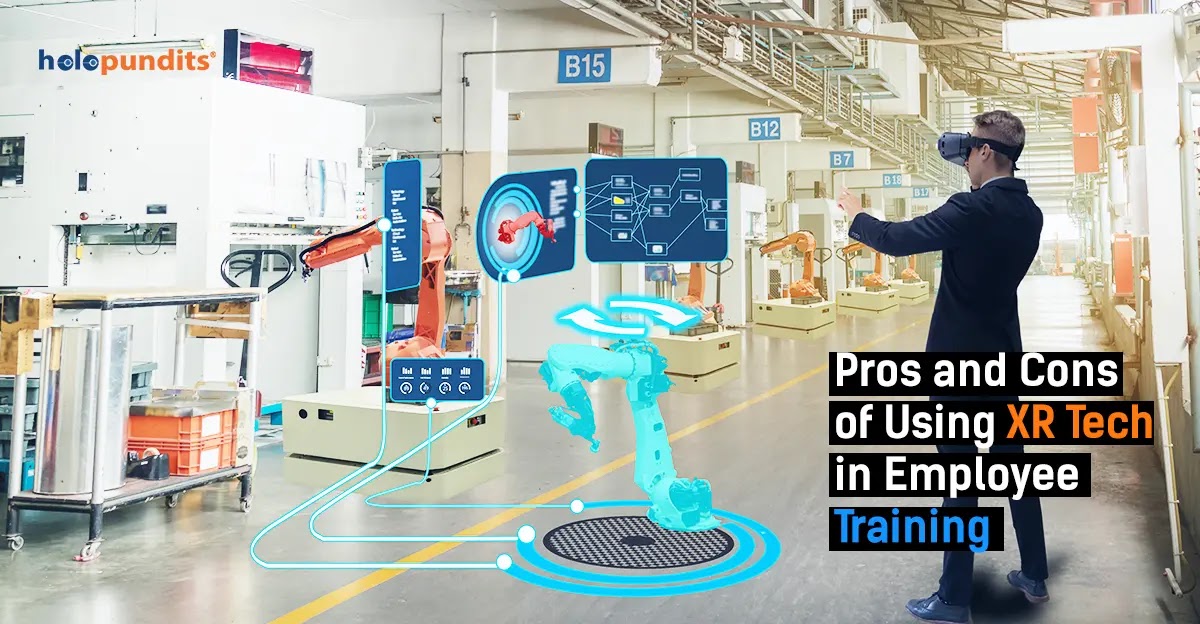Pros and Cons of Using XR Tech in Employee Training

Technology is at the heart of our daily lives. With the emergence of cutting-edge technologies like virtual, augmented, and extended reality, our lives have become more advanced. People often see these technologies as tools to enhance the entertainment industry. XR may have entered the limelight via the gaming and entertainment industry, but the potential of XR technology is not limited to this one sector. A study projects the XR market to grow from $26.05 billion in 2020 to $463.7 billion by 2026, growing at a Compound Annual Growth Rate (CAGR) of 62.7%.
Businesses have started to realize the potential of Extended Reality (XR) technology and are adopting XR in the corporate training process to give their employees a fully immersive training experience. Continue reading to learn the pros and cons of utilizing extended reality technology for corporate training.
Advantages of Using XR Technology for Training
1. Enhanced Visual Training
XR technology can make training more efficient as learners can visualize the content through visual 3D models. Extended reality in training helps employees get a clear understanding of concepts and processes for it enables trainees to see, feel, and experience the content. Studies show that visuals help learners process information faster and retain information for a longer period. For example, consider complex equipment training. With XR, trainees can view 3D models of machines, explore individual parts, and learn additional information about each component, which better prepares employees to work with the equipment in real life.
2. Creates a Safe Training Environment
Real-life training activities can involve a high degree of risk, one wrong move could have devastating real-life consequences. However, XR technology in training offers a safe environment for employees to train and eliminates the risk of causing harm to individuals or expensive equipment. This allows employees to make mistakes and learn from them without worrying about the outcomes of their actions. It enables trainees to practice as often as necessary, get familiar with the procedures, safety protocols, and hone their skills without harming anything.
For example, in medical training, while practicing on a real-life patient, a small slip of the scalpel can cause severe harm or worse. With XR, learners can practice surgeries and other high-risk operations in a virtual environment multiple times until they are ready to operate for real.
3. Enhanced Employee Engagement
Extended reality technology creates fully immersive simulations, experiences that make training more fun and engaging for employees. The highly immersive nature of XR and the life-like visuals boost trainee engagement. Let us be honest; learning by participating in immersive simulations and games does not actually feel like work, correct? Gamified XR content makes the training process challenging, exciting, and motivates trainees to actively participate in training activities and complete tasks in a fun and interactive manner.
4. Better Retention Levels
Visualized, immersive training with XR significantly improves knowledge retention levels. "Learning by doing" helps learners remember information for longer periods than traditional training methods. A study by the National Training Laboratory finds the retention rates for lectures and reading were 5% and 10% respectively, whereas retention rates were 75% for learning with VR.
5. Powerful Analytics
XR technology in training opens the door for advanced analytics and new metrics. XR tech uses sensors to collect valuable real-time data such as eye-tracking, gestures, behavioral patterns, body language, etc. These measurements help organizations determine the effectiveness of the training program and identify the areas of improvement. This assists companies in monitoring the training progress, employee engagement levels and addressing the shortcomings of the training program to ensure successful outcomes from the program.
Disadvantages of Using XR Technology for Training
1. High Costs
XR technology offers a fun, interactive, engaging platform for employee training, but it does come at a cost. The cost of XR equipment and the initial software development can be expensive. Setting up XR in the work environment can become expensive, so companies with a small budget may struggle to afford XR. However, the long-term financial benefits more than offset the upfront costs. Also, with technological advancements, XR is becoming less expensive and more affordable for everyone.
2. Potential Health Hazards
Some people can experience headaches, eye pain, and nausea while using Head Mounted Devices (HMD) for a long time. Spending too much time in the virtual world can cause motion sickness.
3. Flexibility Deficiency
XR-based employee training lacks the flexibility of a traditional format. In a conventional setup, trainees have the liberty to stop at any moment and ask questions. However, XR training programs are designed to operate in a specific way, so it is difficult to pause the training at the desired moment. It can be a key issue for the ability to comprehend information differs from person to person.
Concluding Thoughts
To summarize, employee training using XR technology offers a cost-effective, safe virtual training environment. The interactive and immersive nature of XR allows trainers to present visually attractive information through stunning 3D visuals. The benefits of adopting XR in training outweigh the disadvantages; many organizations are realizing the immense potential of extended reality technology and are gearing up to deliver immersive training experiences. So, join the XR party; reap the benefits of using XR in business to improve your bottom-line and leapfrog your competitors.
Curious about XR-based training in a corporate environment? At HoloPundits, we have a tech-savvy team specialized in developing immersive tech solutions. Our goal is to help companies embrace XR, we promise to work with you to understand your requirements and develop cost-effective, custom business solutions.
Contact us for a free consultation on using extended reality for employee training
Claim Your Free Consultation



Comments
Post a Comment